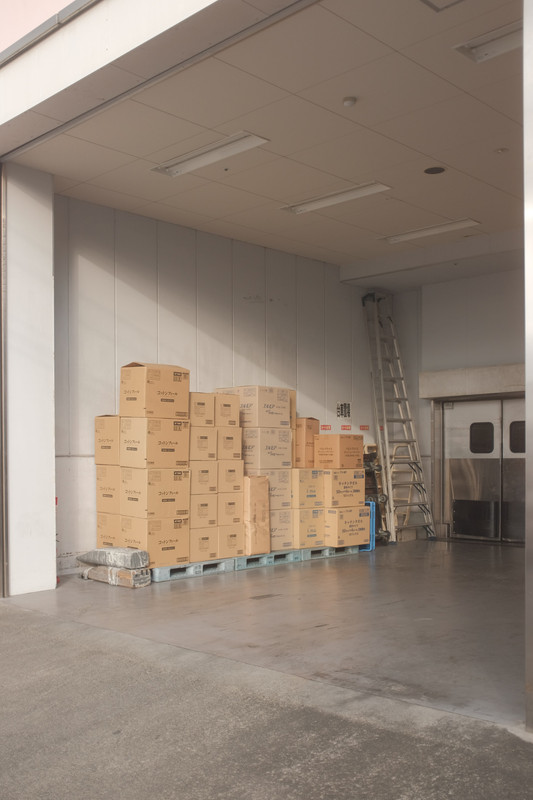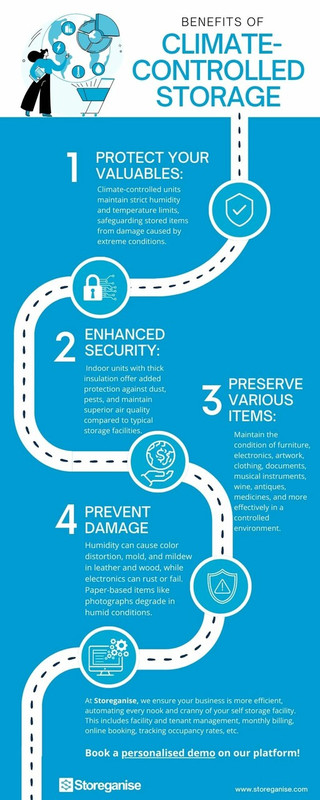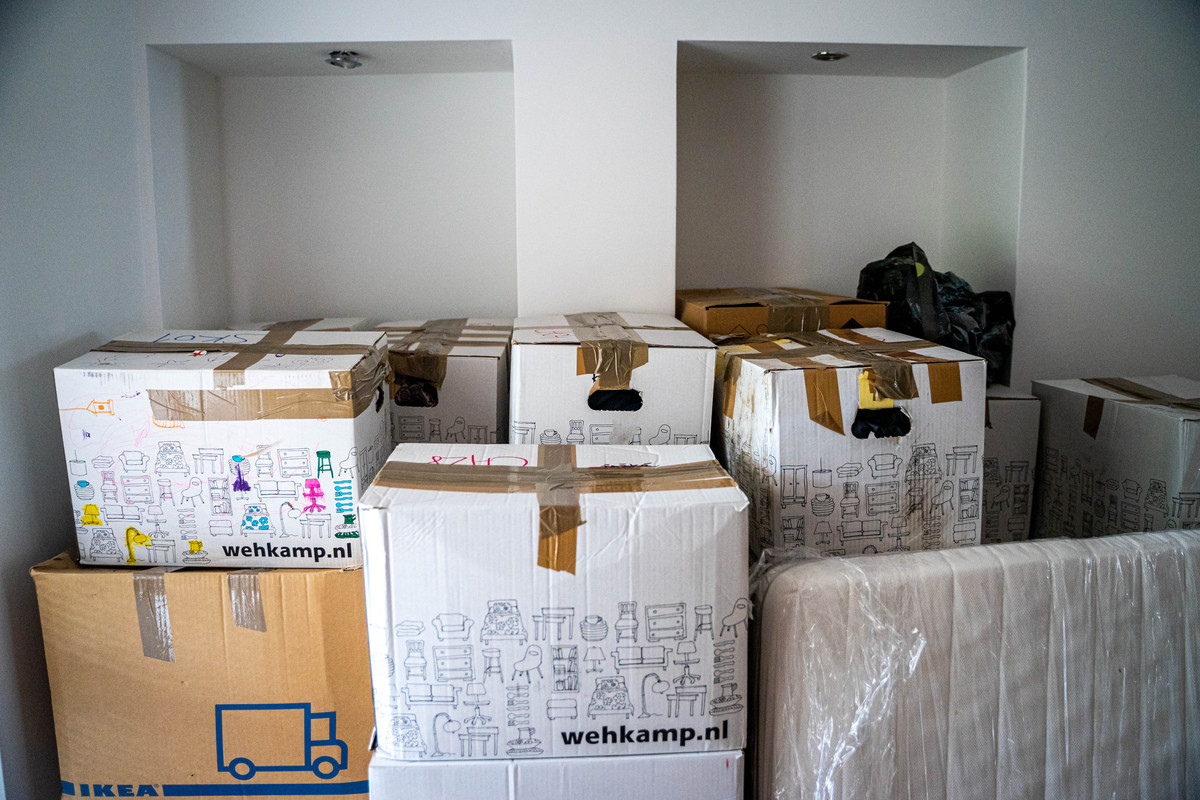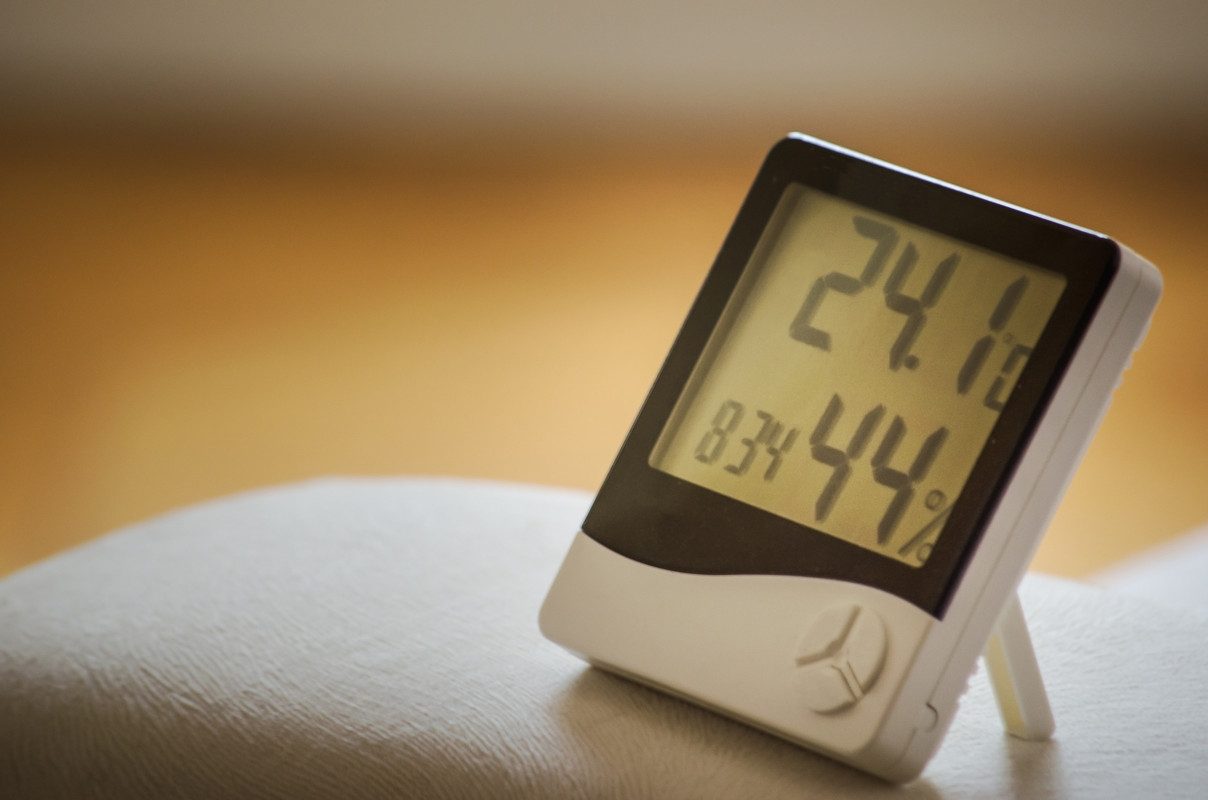What Does Climate-Controlled Storage Mean? (2026 Guide)
Learn about climate-controlled storage, its advantages, and whether installing it is a good idea.

Self-storage is no different from any other industry because it advances via innovation and fresh ideas. For instance, the development of climate control facility units in recent years has been significant increase.
Customers have demonstrated how tempting it is to have the choice to store their belongings in climate-controlled facilities, whether for safeguarding priceless objects or adjusting to extreme weather swings.
Join us as we examine what climate-control storage units entail, items that are best preserved in them, and if they’re truly worth it, among other related topics.
What Does Climate Control Mean?
Climate-controlled storage is a storage model that allows you to control the temperature and humidity in the storage unit. Since high humidity reduces the air’s ability to retain heat, low humidity helps to keep temperatures low. Temperature and humidity control is essential for maintaining the right conditions in a storage unit and when clients use the area to store items that must be kept in good shape for a period of time.
Download the ultimate Self Storage e-book
Everything you need to know about setting up your self-storage facility.
Storage organisations are adopting cutting-edge HVAC systems to maintain tight temperature and humidity conditions (heating, ventilation, and air conditioning). These systems often include a combination of dehumidifiers, air conditioners, programmable thermostats, and intricate insulation.
Here are some more reasons why you should consider climate control storage units as a storage facility owner:
-
Increased revenue: Climate-controlled storage units typically command higher rental rates than non-climate-controlled units. This is because climate control is a valuable feature that many customers are willing to pay extra for.
-
Attract and retain customers: Climate control can help to attract and retain customers, especially those who need to store sensitive items. Customers are more likely to choose a storage facility that offers climate control, and they’re also more likely to opt for a facility that they are confident can protect their belongings.
-
Reduce damage and loss: Climate control can help to limit damage and loss to stored items. This is because climate control helps to prevent the growth of mould and mildew, which can damage items such as furniture, electronics, and clothing. Climate control can also help to prevent pests, such as insects and rodents, from infesting storage units.
-
Improve the image of the facility: Climate control can help to improve the image of a storage facility. Customers are more likely to view a storage facility as professional and trustworthy if it offers climate control. This can lead to more referrals and repeat business.

In addition to the above benefits, climate control can also help to extend the life of a storage facility. By protecting the building from the elements and preventing the growth of mould and mildew, climate control can help to keep the facility in good condition for longer. This can save you money on maintenance and repairs in the long run.
If you are a storage facility owner, it’s recommended you consider installing a climate control system. It’s a worthwhile investment that can benefit your business in many ways. However, you have to choose between an AC and a dehumidifier.
While air conditioning (AC) can quickly reduce the humidity—lowering the temperature in the process—AC systems are typically more expensive and have inaccurate humidity adjustments. On the other hand, dehumidifiers are less expensive to operate and use less energy while controlling humidity. Still, they take much longer to adjust to the desired humidity level.
Why Is Climate-Controlled Storage Beneficial?
It’s understandable to wonder why climate-controlled storage units facility is beneficial and alluring to clients, given the additional specialised equipment required. Many products that consumers store now undergo damage if they aren’t kept in environments with stringent humidity and temperature limits. Consequently, clients who store valuables or objects with more care in your storage units will value the ability to regulate the environment inside the units.
Climate-controlled storage containers are always indoors with thick insulation, giving your customer an added security measure against errant dust or pests. A storage unit with good ventilation also has superior air quality than a typical storage facility. Accordingly, clients who store valuables or objects requiring more care in your storage units will value the ability to regulate the unit’s internal environment and, ultimately, pay more.

When it comes to long-term storage, many customers may spend a bit more for added confidence, knowing that their belongings will return in the same condition as they were before storage.
Here are a few items that one can effectively preserve in a controlled environment:
- Furniture (any piece constructed with or containing wood, wicker, metal, upholstery, or leather)
- Additional items constructed with the above materials
- Electronics
- Media (DVDs, Videos, Vinyl Records, etc.).
- Artwork
- Clothing, especially lace or leather, will be kept in bags.
- Important documents
- Photographs
- Musical instruments
- Wine
- Antiques
- Collectables (Stamps, Coins, Comic Books, etc.)
- Medicines and medical supplies
- Makeup and personal items.
- Appliances for the home
- Sports equipment
- Bicycle seats are made of leather.
It becomes more evident why these items need to be kept in a climate-controlled environment when considering how they behave under humid conditions.
In addition to changing the colour of leather and making it more prone to mould and mildew, moisture can cause wood to distort, fracture, or rot. Similarly, electronics can rust or fail with time, rendering them unsafe or unusable. Paper-based items, such as photographs, also tend to disintegrate or lose their legibility.

How Your Customers Should Prepare Items for Climate-Controlled Storage
Your clients can take full advantage of a climate control storage unit by taking the following steps:
1. Determine the Items They Will Be Storing.
Getting valuable belongings into a self-storage facility will be much more convenient if your customers have a plan for how they’ll store them.
Ask them to make a list of the items they will be putting away before they do anything else. Then, make sure they organise the things into categories to store related products together.
Remind your customers to take measurements and ensure they’re making the most of their space because their storage unit only has so much area.
You can add this to a newsletter or send them a notification when they become a customer. Without reminding them, they could come back and blame you when things go wrong.
2. Start Classifying the Items.
Help your customers by giving them access to the appropriate supplies to keep things organised before moving stuff into storage. Allowing them to purchase packaging supplies, such as boxes and containers, bubble wrap, newspaper, and blankets, will safeguard the objects they store in storage containers.
3. Endeavour To Pack Items Intentionally.
Once they have figured out the above, it’s time to pack. For valet storage facilities, you may even be picking the stuff up for them.
To reduce damage during the move, group things together and provide as much area for movement as possible. Cover their precious items with bubble wrap or newspaper to prevent dust accumulation and damage from other objects in the box or container. Additionally, put any broken or fragmented materials, such as nuts and bolts, in a tiny bag.

If you own a climate-controlled storage unit to rent, consider providing these tips via email or offering free bubble wraps to make your storage attractive to business customers.
4. Move Your Customers’ Items to Climate-Controlled Storage.
If your customers are moving into the facility themselves, ensure they know the gate hours and any storage policy restrictions before going to the self-storage facility. Also, provide them with a layout of their unit.
Storeganise provides self storage business owners with the capabilities to manage their facility remotely, allowing customers to complete this step entirely by themselves. Check out our software to see how it works.
What Items Are Best Preserved in Climate-Controlled Storage Units (and Why)?
Although we outlined a long list of items that may benefit from climate-controlled storage, some should be stored only in these facilities. That said, many clients will particularly keep certain sensitive items in a climate control facility even though traditional storage or temperature-controlled storage works perfectly for other things.
Here are the most popular ones and why:
-
Art: Artwork typically contracts or expands with changes in humidity and temperature, which means its quality will diminish over time.
-
Electronics: If maintained in the wrong conditions for a long time, electronic devices, especially circuiting components, will mould or oxidise.
-
Delicate fabrics or paper items: Delicate fabrics or papers can mould in humid environments, while excessive temperatures can cause paper products to become yellow.
-
Vinyl: The risk of warping increases with increasing temperature, whereas the chance of breaking increases with decreasing temperature.
-
Antique wood or metal items: All metals will oxidise and change colour in response to airborne moisture, whereas wood will expand and contract in response to temperature, making it vulnerable to rot and mould.
-
Wine: Wine stored in an atmosphere that is too humid may mature too quickly, affecting its colour and opacity. White wine stored in an environment that’s too dry may experience brittle corks that compromise the wine’s seal quality. To store wines, consider delving into wine storage options.
What Is the Price of Climate-Controlled Storage Units
If you want to provide a climate control facility, be prepared to charge a higher rental fee — between 25% and 50% more than you would for a typical unit. According to the Self Storage Association (SSA) UK Annual Industry Report, the average price to rent a self-storage unit in the UK is £23.94 per square foot. For your unit, 25% more would get you closer to £30, and 50% more would put you closer to £35 monthly
Across the globe, these prices vary - we specialise in the US, UK, Australian, Canadian and New Zealand market, so feel free to reach out if you’d like to learn about your local area.
Alternatively, research your area to learn how much a climate-controlled storage unit costs because storage unit prices greatly differ between facilities, types of storage and areas. Also, keep in mind that £23.94 is only an average in the UK. It’s worthwhile to charge customers the additional expense if they’re storing valuable items or items that could become inoperable due to extreme heat and humidity.
Things to Consider When Choosing Climate-Controlled Storage
Most of your customers’ delicate objects don’t necessarily need to be kept in a certain temperature range. However, they need constant temperatures that your climate control facility should be able to regulate. The standard temperature range for climate-controlled storage spaces is 55–85 degrees Fahrenheit, with a base humidity of 55%. These criteria are usually sufficient for most items, but others call for an even smaller range of temperature variations.
Bear this in mind, as customers will expect you to know what conditions are best for their items. To help out here, ensure your self storage website has clear recommendations for clients to read. It’s crucial to understand that climate-controlled differs from temperature-controlled. Although they’re distinct, these terms are interchanged in some facilities.
Temperature control affects temperature; it doesn’t affect humidity, which can occasionally do more damage than temperature. To attract customers who desire steady temperatures and humidity year-round, regardless of the weather, ensure your facility provides true climate control with temperature and humidity adjustment.

Facilities that merely use air conditioning to chill their units may not reduce moisture levels low enough to safeguard against all kinds of unwanted damage. For antique furniture and other antiques your clients don’t want to warp or rot, it’s especially crucial to actively dehumidify the air in your units.
Just as too little humidity can be harmful, so can too much humidity. Low humidity during the winter months is a common problem for buildings that don’t have humidity control, which can lead to the brittleness of paper, the cracking of paint on the artwork, and the drying out and splitting of wooden objects.
Additionally, offering climate monitoring will allow you to charge more. That is, continuously checking the temperature and humidity to ensure that your clients’ belongings are stored at suitable and dependable levels. Moreover, your building should have a constant air circulation system to keep the air clean and fresh.
Here’s a quick overview of the various features our self-storage software has if you’d like to further improve your offering.
Is Climate-Controlled Storage Units Worth It?
While there are many benefits to a climate control facility, there are also some drawbacks. For one, they’re significantly more expensive to build and maintain because of several architectural factors like insulation, HVAC equipment, and size. However, climate-controlled storage units are incredibly well-liked and lucrative in the proper areas because clients are drawn to their ability to offer the greatest protection of their belongings against the outside world.
If you want to save money, don’t have the extra space and aren’t based in an area with extreme temperatures, then you probably shouldn’t opt for climate-controlled storage.
5 Factors to Consider When Determining if You Should Offer Climate-Controlled Storage
Before opting for a climate control facility, you should consider running through this checklist:
1. Where in the World Are You Based?
Use climate-controlled storage if you’re based in a place with excessive heat and humidity.
2. What Are Your Clients Storing?
We’ve provided a list of items clients can store in a climate-controlled facility and those that should mandatorily be stored in controlled environments. In addition to that list, are your clients storing priceless possessions? Determine the value of the items they need to store; if it includes treasured family artefacts, you should choose climate control for the security it provides for your customers.
3. How Long Will Your Clients Keep Items in Storage?
If your clients keep items in storage for a long time, it may be best to opt for a climate control storage unit to keep things from deteriorating due to seasonal changes.
4. Are Clients Storing Things That Might Break, Change Colour, or Warp in Storage?
Climate-controlled storage is your best choice if clients need to keep items that changes in temperature or humidity could harm.
5. Does Your Facility Have Climate Control and Security Features?
If you aren’t offering automated systems and top security, are your clients likely to even want climate-controlled storage in the first place? If you do have top-notch security (which you should), then you should also offer additional services, like climate-controlled storage options.
Conclusion
Some self-storage facilities don’t provide climate-controlled storage units, while others do; hence, always look at the competition and your clients’ needs to see whether you should. Make sure your website is very clear if you offer climate-controlled storage, as this can be a unique selling point locally.
At Storeganise, we ensure your business is more efficient, automating every nook and cranny of your self storage facility. This includes facility and tenant management, monthly billing, online booking, tracking occupancy rates, etc.
Get a firsthand look by claiming a free account or booking a personalised demo on our platform.
Understanding the broader industry landscape can be invaluable as you consider the benefits of climate-controlled storage for your facility. Discover how storage associations shape these standards and practices worldwide by exploring global insights from storage associations.
Frequently Asked Questions
Do I Need Climate-Controlled Storage for Electronics?
Simple self-storage is adequate for a wide variety of diverse household, commercial, or yard objects. However, a climate control storage unit is essential and strongly advised for delicate goods like fine art, musical instruments, antiques, or electronics.
What’s the Benefit of Climate-Controlled Storage?
The objects stored there are better protected from harm by the storage unit’s constant temperature. On the other hand, heat and humidity can cause wood or leather furniture to warp, crack, or break.
What Items Need To Be Stored in Climate Control?
Items that one may preserve in climate-controlled storage units include the following:
- Antiques and family heirlooms
- Anything made of paper, plastic, or wax
- Vinyl
- Electronics
- Furniture
- Artistic creations
- Cosmetics
- Medical supplies
- Clothes
- Linens
- Fabrics
How Much Does a Climate-Controlled Storage Unit Cost?
The cost of a climate control storage unit depends on its size and where you live. In the UK, for example, compared to a typical open-air storage container, expect to charge 25%– 50% extra on climate control. This amounts to about £30–£35 per square foot in the UK.
